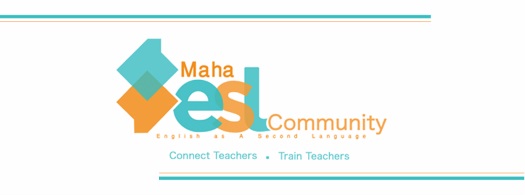
A New Contribution to Bloom’s Taxonomy
Maha Hassan, Egypt
Maha Hassan is a teacher Trainer and Founder/Ceo of Maha ESL Community. She is former Head of English Dept. at the Arab Academy for Training Technology. She has presented at a number of international and national conferences. She also has papers published on Howtolearn.com, Nile Tesol Newsletter and IATEFL Voices 255. She has been in the teaching career for more than 30 years.
E-mail: maha.professionaltrainer@gmail.com,
www.facebook.com/maha.esltraining, http://teachingenglishcafe.blogspot.com.eg/
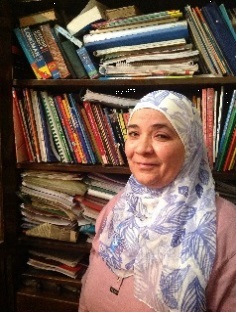
As Bloom divided the stages of learning, he concentrated on the Cognitive side dividing learning as a whole to the six well-known steps starting with Knowledge, Comprehension, Application, Analysis followed with Synthesis ending with Evaluation. Even when his followers, Anderson and Krathwohl, revised it, they concentrated on the same Cognitive Domain just changing the nouns into verbs. (Figure 1)
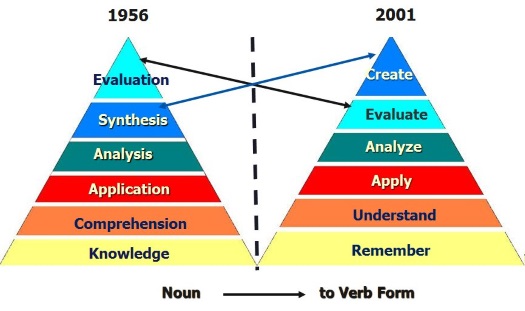
(Figure 1) Diagram 1.1, Wilson, Leslie O. 2001)
Remember, Understand, Apply, Analyze and exchanged places between the last two to end with Evaluate and Create. They analyzed each stage and tried to figure out what kind of actions (verbs) could be performed or practised by the students. They gave us long lists of verbs which often confused teachers rather than helped them. Teachers would feel rather “shocked”, “Do I have to do all this?!” What if I haven’t covered them all?!”Yet another suggestion came later on in the form of a wheel using both the old and the new Taxonomy with the actions (verbs) expected and the outcomes.
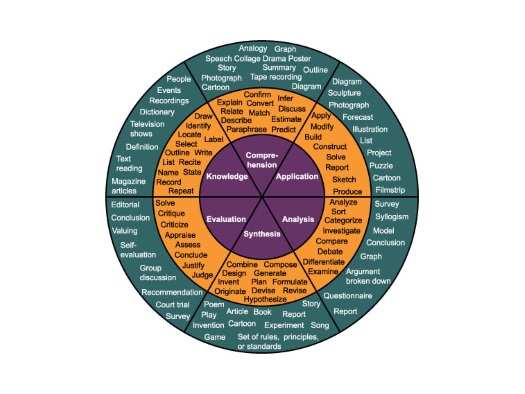
Figure (2) The Wheel
On the other hand, Rex Heer from Lowa State University Centre for Excellence in Learning and Teaching came out in March 2009 with the steps figure to combine, for the first time, The Cognitive Dimension with the Knowledge Dimension giving a wider perspective of the teaching process. It shows that this process is a buildup that gave teachers a wider scope of the teaching procedures and how to reflect on them.
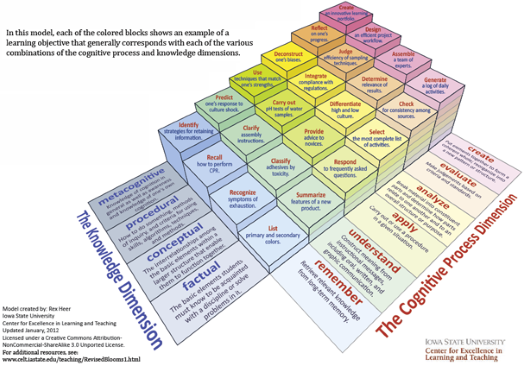
Figure (3) Model created by: Rex Heer / Lowa State University
Similar revisions and other studies of the concepts were introduced until Andrew Churches came up in 2007 with a new idea to introduce Bloom’s Digital Taxonomy. “His intent was to ‘marry’ Bloom’s Cognitive levels with 21st Century digital skills.” (Bloom’s Taxonomy: What’s Old is New Again, Cecelia Munzenmaier with Nancy Rubin, The Learning Guild Research, p.26, www.elearningGuild.com). “Churches added ways to use Web 2.0 technologies to each cognitive level in Bloom’s revised taxonomy, as shown in Figure (4). Making it easier to retrieve information by bookmarking a site is a way of Remembering. Commenting on a blog post is a way of Evaluating. Blogging is also a way of Creating. What determines Cognitive Level is not the tool itself, but how the technology is used.” (ibid, p. 26) Not only that, but “while Churches retains the revised Bloom’s hierarchical arrangement of categories, he does not believe that learners must always start with Remembering and work their way up. Lower-level skills such as searching can be used or even learned within the context of a critical thinking activity.” (ibid, p. 27).He referred to the lower categories as “Lower Order Thinking Skills (LOTS)” and the higher ones as “(HOTS) or Higher Order Thinking Skills”.
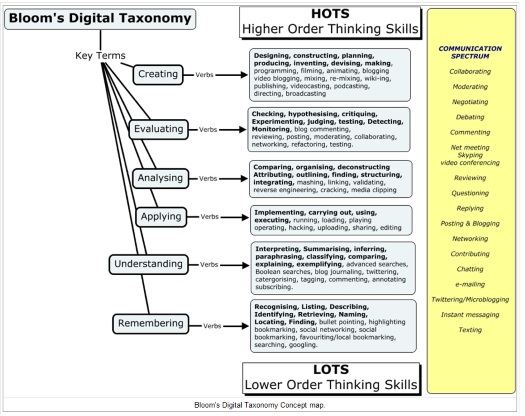
Figure (4)
Educational
Origami;
http://edorigami.wikispaces.com/Bloom%27s+Digital+Taxonomy
If we take a good look at the steps taken, we find that every now and then people get a better view or perspective of Bloom’s Taxonomy. You don’t feel it is weird or unacceptable, they are a kind of buildup. They complete each other, you feel that we get a better perspective every time as our life gets more and more complicated. Educational systems are changing and developing and thus our perspective of Bloom’s Taxonomy.
Along the same lines came my contribution. As I mentioned before, the previous revisions dealt with the Cognitive Domain, The Knowledge Domain etc., they all set the actions and outcomes of the domains discussed. Yet taking a deeper look, we need to ask ourselves why shouldn’t we get deeper into the process and apply it to the Four Skills of Teaching the Language. These are the core gears that move the teaching process around. Without these skills we won’t be able to follow Bloom’s steps to better education and fulfillment of acquiring the language.
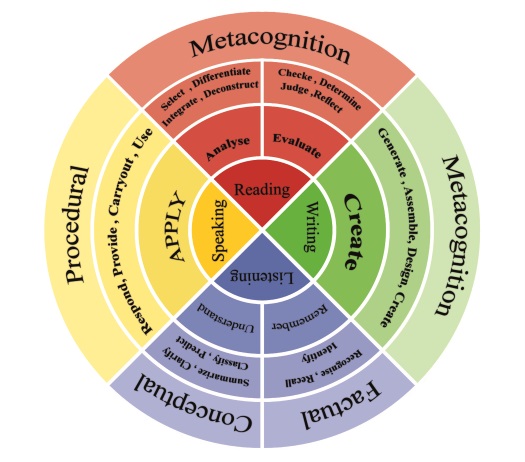
Figure (5) Model created by Maha Hassan: The Integrating Wheel
Looking deeper into the core of the teaching process (figure (5) I created), we find that Listening involves Remembering the past words and phrases in order to understand the new context we are dealing with. Referring to Rex Heer’s steps, we find that the Learner has to recognize, Recall and identify words, phrases and sentences he has previously studied as a first step. On the second step to ‘Understanding’, the learner summarizes, classifies, clarifies and predicts. With ‘Remembering’ the Learner deals with (goes through) the Factual Domain which transfers him spontaneously to the Conceptual Domain (refer to figure 3) by dealing with “the interrelationships among the basic elements with a larger structure that enables them to function together.” (ibid, the steps figure, p. 22). For example: when the teacher starts introducing a new lesson or a group of new words, the students have to recall older information to be able first to understand the teacher and then form a link between the past information and the new one in order to understand the new lesson. Here the student ‘recalls’ the old words or info, ‘identifies and realizes’ them. These are considered facts, that’s why we call this stage “Factual Domain”. The student then starts moving to the next stage “The Conceptual Domain” where he/she relates the words he/she knows to the listening situation and thus be able to understand or grasp the new meanings introduced to him/her and therefore, be able to solve the questions given whether it’s fill in the spaces, true or false, choose or give answers to.
Then followed by ‘Speaking’, the Learner: responds, provides answers in a conversation or the like, then carries out ‘a communication activity’ and then uses it in ‘real life situations’. Here the Learner responds to questions and requests, provides answers to different questions with different tenses and structures, carries out a dialogue in a real life situation, and thus uses the ‘understood’ knowledge to apply what he has learnt. Thus the Learner goes through the Procedural Domain (The Knowledge Dimension).
Moving to the ‘Reading’ section, we find that the Learner starts Analysing: selecting, differentiating, integrating information to make sure that they grasped the whole meaning. The Learner can also, with the help of the teacher, deconstruct sentences in order to make sure he/she understands what the context is about. Thus the last three steps (select, differentiate, integrate) overlap and integrate to give a full picture of the text at hand.
After that the Learner, with teacher guidance, starts answering different kinds of questions like subjective, objective questions, true or false, fill in etc. This is checking and determining. These are followed by the final part: what do you think of the writer’s opinion? Do you agree or disagree? What if you were in such a situation? Thus judging and reflecting. The Cognitive Domains concerned ‘Analysing and Evaluating’ intersected with the ‘Metacognitive Domain’ of The Knowledge Dimension’.
Finally, we come to the ‘Writing’ Process. Here Learners: generate new ideas out of the work they have evaluated; assemble them in a piece of writing, chart, magazine etc., design a way of displaying these ideas and thus ‘Creating’. These are the skills performed at the top of the ladder thus showing the Metacognitive Domain of the Learners. It’s their knowledge and awareness of that Knowledge that counts. If they realize the Knowledge they have reached, they would consolidate it in a wonderful way.
Thus through this Wheel (figure 5 I created) we try to have a deeper look at the relationships between the Four Skills and the Cognitive and Knowledge Domains as well as the steps of Bloom’s Taxonomy. It’s the integration between these approaches that form the learning process in the end. If the teachers realize what their teaching processes or lesson plans would lead to, they would be careful enough with the buildup of their work. Not only that, but it would help create the “teacher¬-researcher”, “an analyst” that checks, reflects and judges his/her work and sees where it leads the students to. If the learning process started with Remembering and ended with Evaluation and Creation; the teaching process started the other way round, Creating and Integrating skills and activities to help students Understand and Retain (Remember) the work done in class!!
Eventually, understanding that the four skills of teaching (listening, speaking, reading and writing) integrate each other and that one leads to the other by following the different categories and actions of Bloom’s Taxonomy and its Revisions, means understanding The Core of Teaching!
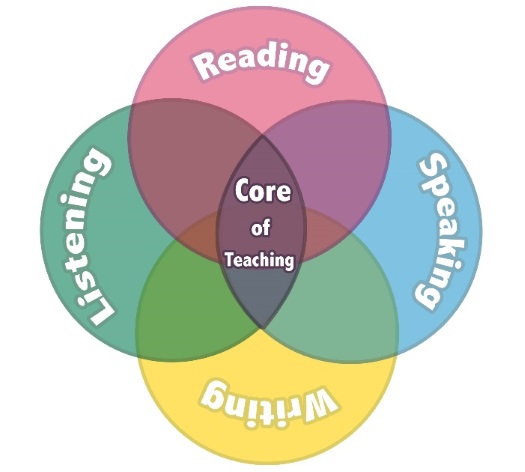
Figure (6) Core of Teaching: created by Maha Hassan
References
Munzenmaier, Cecelia and Rubin, Nancy, Perspectives: Bloom’s Taxonomy: What’s Old is New Again, The ELearning Guild Reasearch, www.elearningGuild.com
Wilson, Leslie O. Diagram 1.1, 2001

Please check the How to be a Teacher Trainer course at Pilgrims website.


|